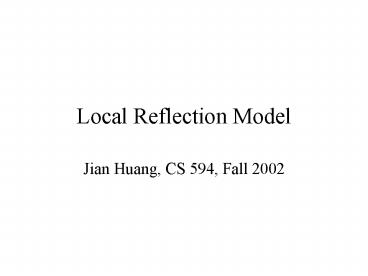Local Reflection Model - PowerPoint PPT Presentation
Title:
Local Reflection Model
Description:
The Phong model is based more on common sense than physics. Perfect specular reflection only occurs on a perfect mirror surface stroke by a thin light beam ... – PowerPoint PPT presentation
Number of Views:20
Avg rating:3.0/5.0
Title: Local Reflection Model
1
Local Reflection Model
- Jian Huang, CS 594, Fall 2002
2
Phong Reflection
Phong specular highlight is a simplification
3
Phong Model - Limitations
- The Phong model is based more on common sense
than physics - Perfect specular reflection only occurs on a
perfect mirror surface stroke by a thin light
beam - It fails to handle two aspects of specular
reflection that are observed in real life - intensity varies with angle of incidence of
light, increasing particularly when light nearly
parallel to surface - colour of highlight DOES depend on material, and
also varies with angle of incidence
4
Physically Based Specular Reflection
- After Phongs work in 1975, Jim Blinn proposed
physically simulated specular component - In 1983, Cook and Torrance extended this model to
account for the spectral composition of
highlights, ie. dependencies on - Material type
- Angle of incidence
- With physically based local reflection model, can
computer pre-computer BRDF
5
Modeling the Micro-geometry
- In reality, surfaces are not perfect mirrors
- A physically based approach models the surface as
micro-facets - Each micro-facet is a perfect reflecting surface,
ie a mirror, but oriented at an angle to the
average surface normal
cross-section through the microfaceted surface
average surface normal
6
Specular Reflection
- The specular reflection from this surface depends
on three factors - the number of facets oriented correctly to the
viewer (remember facets are mirrors) - incident light may be shadowed, or reflected
light may be masked - Fresnels reflectance equations predict colour
change depending on angle of incidence
7
Orientation of Facets
- Only a certain proportion (D) of facets will in a
particular direction, e.g. viewing direction
light
H
eye
8
A Statistical Distribution
- Cook and Torrance give formula for D in terms of
- Gaussian distribution D k exp-(a/m)2
- a angle of viewer (angle between N and H)
- m standard deviation of the distribution
- Assumptions
- Small micro-facets is still larger than the
wavelength of light in size - Diameter of the light beam can intersect a large
number of micro-facets to be statistically correct
9
Shadowing and Masking
- Light can be fully reflected
- Some reflected light may hit other facets
- Some incident light may never reach a facet
Cook and Torrance give formula for G, fraction of
reflected light, depending on angle of incidence
and angle of view
10
Degree of Masking and Shadowing
- Dependent on the ratio l1/l2
- G 1 - l1/l2
- L light vector, V view vector
- H (LV)/2
- For masking Gm 2(N.H)(N.V)/V.H
- For shadowing Gs 2(N.H)(N.L)/V.H
11
The Glare Term
- Usually, as the angle between N and V approaches
90, one sees more and more glare - You are seeing more micro-facets
- Need a term to account for this effect
- 1/N.V
12
Recap Snells Law
13
Fresnel Term
N
reflected
In general, light is partly reflected, partly
refracted Reflectance fraction reflected
?
f
refracted
Refractive Index ? sin f / sin ? Note that ?
varies with the wavelength of light The
Fresnel term (the reflectance, F), of a perfectly
smooth surface is given in terms of
refractive index ? of material and angle of
incidence ? F is wavelength dependent!
14
Fresnel Term
- Dont know how to calculate F for arbitrary ?
directly, so usually started with a known or
measured F0. - F is a minimum for incident light normal to the
surface, ie ? 0 F0 ( ? - 1 )2 / ( ? 1 )2 - So different F0 for different materials
- The refractive index ? of a material depends on
the wavelength, ? , so have different F0 for
different ? - burnished copper has roughly
- F0,blue 0.1, F0,green 0.2,
F0,red 0.5
15
Fresnel Term
- As ? increases from 0 ...
- F? F0 ( 1 - cos ? )5 ( 1 - F0 )
- so, as ? increases, then F? increases until F90
1 (independent of ? ) - This means that when light is tangential to the
surface - full reflectance, independent of ?
- reflected colour independent of the material
- Thus reflectance does depend on angle of
incidence - Thus colour of specular reflection does depend on
material and incident light angle
16
Specular Term
- This leads to
- Rs( ? ) F( ??) D G / (N.V)
- where
- D proportion of microfacets aligned to view
- G fraction of light shadowed or masked
- F Fresnel term
- N.V glare effect term
- In practice, Rs is calculated for red, green,
blue - Note it depends on angle of incidence and angle
of view
17
Cook and Torrance Reflection Model
- The specular term is calculated as described and
combined with a uniform diffuse term - Reflection (angle of incidence, viewing angle)
- s Rs d Rd
-
(where s d 1) - Known as bi-directional reflectance
- For metals d 0, s 1
- For shiny plastics d 0.9, s 0.1
- Its BRDF does not depend on the incoming azimuth
18
Aluminium
19
Bronze
20
Chrome
21
Stainless Steel































